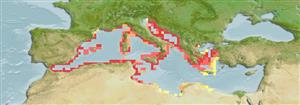Common names from other countries
Environment: milieu / climate zone / depth range / distribution range
Ecologia
marinhas demersal; intervalo de profundidade 2 - 15 m (Ref. 5981). Subtropical; 18°C - 22°C (Ref. 13614); 47°N - 30°N, 6°W - 28°E
Mediterranean Sea: Adriatic Sea, Tunisia (Ref. 42506), and Turkey.
Tamanho / Peso / Idade
Maturity: Lm ? range ? - ? cm
Max length : 18.0 cm TL macho/indeterminado; (Ref. 5981)
Descrição suscinta
Chaves de identificação | Morfologia | Morfometria
Espinhos dorsais (total) : 11 - 13; Raios dorsais (total) : 23 - 27; Espinhos anais: 2; Raios anais : 25 - 28.
Facultative air-breathing in the genus (Ref. 126274); Adults occur among seagrass, sometimes on rocky bottoms. Eggs produced by several females are guarded by male. Individuals are first females then change to males (Ref. 5981). Oviparous. Eggs are demersal and adhesive (Ref. 205), and are attached to the substrate via a filamentous, adhesive pad or pedestal (Ref. 94114). Larvae are planktonic, often found in shallow, coastal waters (Ref. 94114).
Ciclo de vida ou comportamento de acasalamento
Maturities | Reprodução | Spawnings | Egg(s) | Fecundities | Larvas
Oviparous, distinct pairing (Ref. 205).
Zander, C.D., 1986. Blenniidae. p. 1096-1112. In P.J.P. Whitehead, M.-L. Bauchot, J.-C. Hureau, J. Nielsen and E. Tortonese (eds.) Fishes of the North-eastern Atlantic and the Mediterranean, volume 3. UNESCO, Paris. (Ref. 5981)
Status na Lista Vermelha da UICN (Ref. 130435)
Can't connect to MySQL database (fbapp). Errorcode: Too many connections
